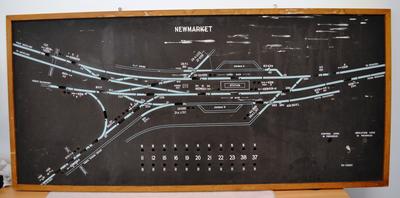Diagram of Signals [Newmarket]
Maker and role
New Zealand Rail, Attributed to
See full details
Object detail
Accession number
2011.296
Maker
Description
Diagram of points and signals at Newmarket Station.
Brief History
This Diagram of Signals was part of the signalling equipment in the signal box at Auckland’s Newmarket Station, located on the North Auckland Line (NAL, but previously also part of the North Island Main Trunk line, NIMT.) The signal box was opened at the same time as the station building in 1909 and was part of the station’s history until 2008 when it was removed for station upgrades. It replaced an earlier signal box on site from 1904 when the NIMT was only one main line. The 1909 signal box coincided with track duplication and rearrangement of the Newmarket yard when movements of trains were still controlled by semaphore signals and mechanical interlocking.
From about 1939 these diagrams of signals were made using oil colours on a black steel plate, like this object. They replaced the earlier red and black ink with water colours on card. This diagram of Newmarket is as the track layout was until the major upgrade for duplication and electrification of the NAL in 2008. As can be seen in the diagram, only colour light signals are shown.
The Newmarket diagram is more complex than the New Lynn one also held by MOTAT because Newmarket was a complicated Junction with more train movements to control. It was also unique because movements from Auckland to the north (NAL) had to propel to the North Backshunt on leaving the station before accessing the NAL via the ‘triangle’ (point 19 on the diagram). There was also a busy freight yard that had to be serviced several times a day, an East and West yard, a Private Siding for Taupō Totara Timber Company, a Brewery siding and, later but not shown on this diagram, ‘Abel’s’ siding. This was along with controlling movements for the two busy Main Lines.
These diagrams worked when an electric current (or track circuit) passed from rail to rail by a passing train would activate a light on the panel to indicate the train’s location on the diagram of signals. The diagram identifies a lever in the signal box by number and the function of each lever is further identified by colour of the lever and face plate. It is the signals that control the movement of trains and instructs the driver to stop (signal at stop, or red) or proceed (green) to the next section or block. The diagram of signals also identifies individual track sections. The break in the green lines indicate the position of an insulated joint, which allows for the isolation of the next section.
From about 1939 these diagrams of signals were made using oil colours on a black steel plate, like this object. They replaced the earlier red and black ink with water colours on card. This diagram of Newmarket is as the track layout was until the major upgrade for duplication and electrification of the NAL in 2008. As can be seen in the diagram, only colour light signals are shown.
The Newmarket diagram is more complex than the New Lynn one also held by MOTAT because Newmarket was a complicated Junction with more train movements to control. It was also unique because movements from Auckland to the north (NAL) had to propel to the North Backshunt on leaving the station before accessing the NAL via the ‘triangle’ (point 19 on the diagram). There was also a busy freight yard that had to be serviced several times a day, an East and West yard, a Private Siding for Taupō Totara Timber Company, a Brewery siding and, later but not shown on this diagram, ‘Abel’s’ siding. This was along with controlling movements for the two busy Main Lines.
These diagrams worked when an electric current (or track circuit) passed from rail to rail by a passing train would activate a light on the panel to indicate the train’s location on the diagram of signals. The diagram identifies a lever in the signal box by number and the function of each lever is further identified by colour of the lever and face plate. It is the signals that control the movement of trains and instructs the driver to stop (signal at stop, or red) or proceed (green) to the next section or block. The diagram of signals also identifies individual track sections. The break in the green lines indicate the position of an insulated joint, which allows for the isolation of the next section.
Marks
NEWMARKET Printed
Media/Materials
Credit Line
New Zealand Rail. Diagram of Signals [Newmarket], 2011.296. The Museum of Transport and Technology (MOTAT).


![Signal Box [Mt Albert Signal Box]; New Zealand Government Rail; 1914](https://collection.motat.nz/records/images/medium/11451/fcec02303cb899a0dfcf67c41b5c6ad46c038569.jpg)
Public comments
Be the first to comment on this object record.